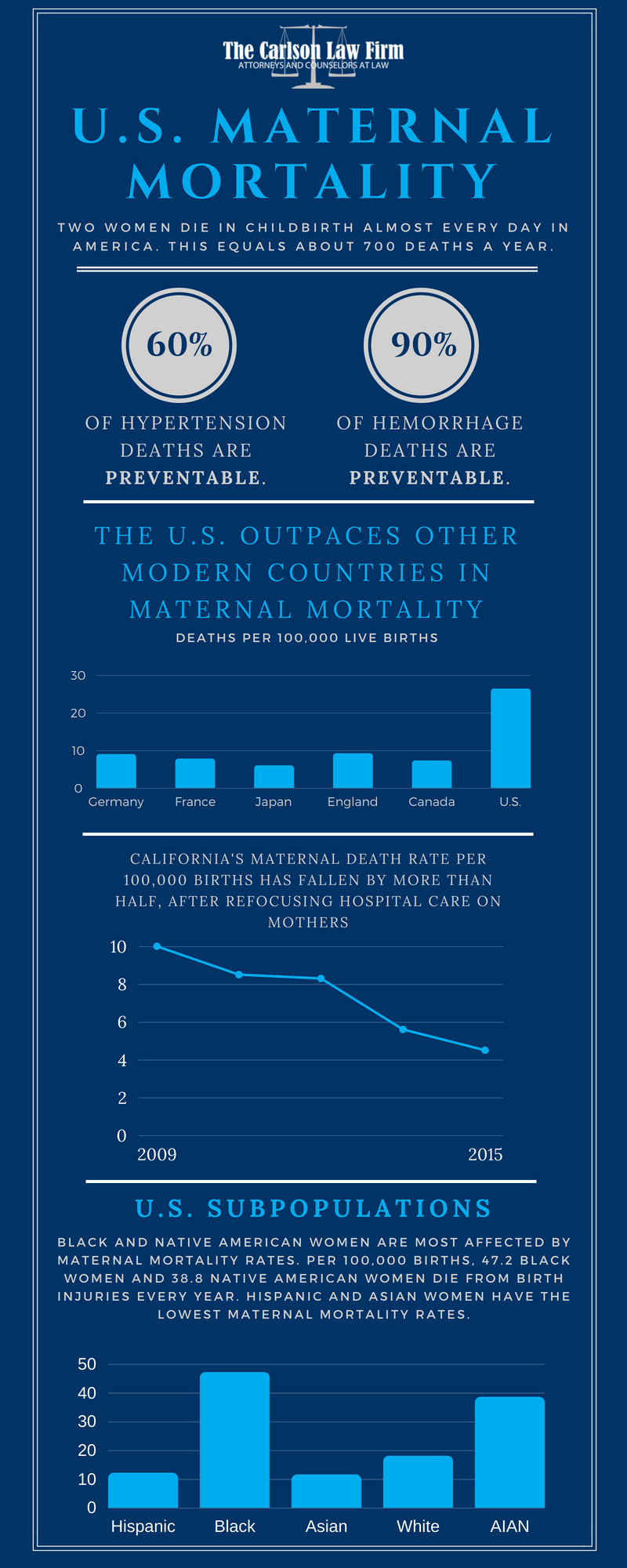Each year, doctors and hospitals make thousands of serious errors that may lead to death or serious injuries. These errors are underreported as there is no law requiring doctors to admit mistakes publicly. And you’ll be hard-pressed to find a doctor or hospital willing to admit their mistakes publicly. These errors often prompt victims of negligence to file medical malpractice lawsuits. When it comes to medical malpractice lawsuits, obstetrics and gynecology doctors account for 11% of suits filed against doctors each year. These doctors are responsible for treating women during pregnancy. Doctors, nurses, and hospitals have come under scrutiny because of the U.S.’s increasing maternal mortality rate—especially when compared to other Western countries.
According to a March 2021 report from the Centers for Disease Control and Prevention, the rate of maternal mortality in the U.S. increased by more than 15% ahead of the COVID-19 pandemic. It is believed that the pandemic worsened conditions for pregnant women in the U.S.
How serious is maternal mortality in the United States?
A recent investigation by USA Today looked into maternal mortality in the United States. The newspaper claimed that “hospitals know how to protect mothers, they just aren’t doing it.” The report found that the U.S. has significantly higher rates of maternal mortality when compared to other developed nations. While other countries’ maternal mortality rates have declined, the U.S. has increased sharply. In many cases, these women aren’t dying from unforeseen medical or childbirth complications—they are dying from hospitals ignoring obvious deadly symptoms.
All over the country, hospitals and medical workers are guilty of medical malpractice. USA Today’s report described hospital staff skipping or ignoring basic practices meant to protect women after giving birth. The health of U.S. mothers is being disregarded as medical professionals choose not to perform simple tasks like weighing pads to identify internal bleeding and monitoring patients with a history of high blood pressure.
How Does Medical Malpractice Occur in childbirth?
Medical malpractice occurs when a health care provider acts negligently and doesn’t treat a patient with the recognized standard of care. In medicine, the standard of care is defined as what a reasonable and prudent medical professional would or would not do under the same or similar circumstances.
The two leading causes of childbirth deaths and injuries in the United States, hemorrhage, and severe hypertension, are among the most preventable. Thousands of women have reported significant bleeding after giving birth to both nurses and doctors, but hospital staff simply don't treat or ignore the women's concerns. As a result, women are left to bleed until their organs shut down.

Can Medical Malpractice Lawsuits Improve Patient Care?
Absolutely. Medical malpractice is a branch of tort law that has two main objectives. The first is to compensate patients injured through the negligence of healthcare providers. The second goal is to deter medical providers from practicing negligently. The system exists because while most doctors act with the best intentions, some in the profession are incompetent or in some other way impaired. While these healthcare providers shouldn’t be practicing, there is no real way to weed them out until they commit a negligent act.
How Does the Medical Malpractice Liability System Work?
If the medical malpractice liability system is working properly, then court verdicts and previously awarded settlements would both compensate injured patients and deter future harmful medical events. Notably, the system’s ability to deter depends entirely on the courts being consistent in rulings.
Although conventional wisdom suggests that a potential lawsuit keeps hospitals from reporting errors, research shows that lawsuits are responsible for starting discussions that improve patient care. Hospitals and healthcare providers do not readily admit to faults with the threat of liability. So without the threat liability, it’s safe to say admission of fault would be far less.
Also, doctors who carry medical malpractice insurance are less likely to behave negligently. This is because insurance providers use various tools to encourage physician competence and reduce the risk of medical malpractice. For example, high-risk doctors will have to pay higher malpractice insurance premiums than their less-risky peers. Further, medical malpractice insurance providers:
- Give doctors information to reduce risks
- Oversee high-risk doctors
- Monitor providers offering new procedures where experience is not necessary to assess risks
Further, in some cases, medical malpractice insurance providers will deny coverage to a high-risk doctor. This can cut a negligent doctor off from hospital affiliations, clinics and in some states close their practice. When laws shield doctors from medical malpractice liability, they essentially eliminate insurance company oversight. In addition, it reduces incentives for carriers and physicians to keep track of and reduce risks.
Medical Malpractice Caps
Families who lose a loved one from birth injuries can file a wrongful death case against a hospital. However, many states have put caps on the amount survivors can recover after losing a loved one to medical negligence. As noted above, one of the reasons the medical malpractice liability system exists is to limit the risk of a physician behaving negligently. In The Deterrent Effect of Tort Law: Evidence from Medical Malpractice Reform, authors Zenon Zabinski and Bernard S. Black examine the correlation between medical malpractice caps and patient injuries. The pair concludes that patients in states with medical malpractice caps were overall less safe. The study also found that medical malpractice provides a general deterrence for hospitals and medical professionals and encourages excellent care.
Another study by the N.Y.U. Law review concludes that medical malpractice claims always play an important role in patient safety. The essay comes to the conclusion that hospital risk managers traditionally responsible for limiting financial losses have become increasingly focused on patient issues. Also, risk managers often promote:
- Increased transparency
- Internal communication
- Communication with patients
Risk managers often work with patient safety officers to enhance hospital safety. Further, a 2013 New York Study found that more than 80 percent of hospitals have a policy of apologizing to patients when errors occur. It also found that hospitals are more willing to discuss and learn from errors with hospital staff.
The study found that several factors account for these changes in hospital behavior. One of those reasons is malpractice lawsuits. More than 95 percent of hospitals integrate information from lawsuits into patient safety efforts. Risk managers and patient-safety personnel report the use of lawsuit data in identifying and addressing errors.
Medical Malpractice Caps Effects on Maternal Mortality
Several factors have an effect on the safety of mothers giving birth in the U.S. For starters; medical practices have begun to focus more on the child’s well-being over the mothers. Most maternity wards are not set up to handle complications that can arise in women after giving birth.
Of the 50 states, nine states and the District of Columbia have the highest maternal death rate. Eight of those have some cap on the number of damages an injured patient can recover. The states with the highest maternal death rates are:
- Louisiana
- Georgia
- Indiana
- Arkansas
- New Jersey
- Missouri
- Texas
- District of Columbia
- South Carolina
- Tennessee
The Carlson Law Firm recognizes that medical malpractice caps aren’t the only reason for negligence in hospitals. For example, California has had a medical malpractice cap since 1975. However, it has the lowest rate of maternal death. This is because the state has made significant strides in cutting its maternal death rate in half.
Black Mothers are Disproportionately Affected by Uncaring Medical Professionals
Serena Williams penned an Op-Ed in February 2018 detailing the harrowing aftermath of what ensued in the days following giving birth to her daughter, Olympia. Williams noted how lucky she was that her medical responded quickly and promptly to a pulmonary embolism that “sparked a slew of health complications” she considers herself lucky to have survived. The reality for pregnant Black American women is that they are three times more likely to die from pregnancy or childbirth-related causes than white or Hispanic women.
There are multiple factors that contribute to racial disparities in maternal mortality. The CDC points to the following:
- Structural racism. Centuries of racism, mistreatment and neglect from medical professionals have created invisible barriers to the level of care Black women receive from the medical system. For example, studies show that Jim Crow-era beliefs persist among white medical professionals that Black people have a higher tolerance for pain.
- Implicit Bias. Attitudes and stereotypes affect understanding, actions and, ultimately, decisions in an unconscious manner. Studies show that implicit bias is directly correlated with the lower quality of healthcare that Black women receive. For example, the failure to recognize the pain of Black patients has the potential to affect the treatment decisions such as cesarean sections,
- Untreated underlying chronic conditions. Black women generally don't have access to even basic healthcare. As a result, they may have untreated health conditions that can affect the health and outcome of their pregnancies.
It's important for hospitals and medical staff to listen to the concerns of all of their patients. If you believe medical negligence contributed to the death of a woman in your life, call The Carlson Law Firm at 800-359-5690. We care. We can help.
The Carlson Law Firm Can Help Victims of Medical Malpractice
A birth injury and maternal mortality are medical malpractice areas that our attorneys at The Carlson Law Firm passionately represent. The term “birth injuries” can refer to an injury suffered by the mother or her baby during labor. While many cases of birth injuries are common complications, some are the result of blatant medical negligence.
If you or someone you love have suffered due to the carelessness of a medical professional, it is in your best interest to contact a medical malpractice attorney at The Carlson Law Firm as soon as possible. Our team has over 40 years of experience protecting the rights of parents and their children. Contact us any time for a free, no-obligation, consultation. We care, we can help.




